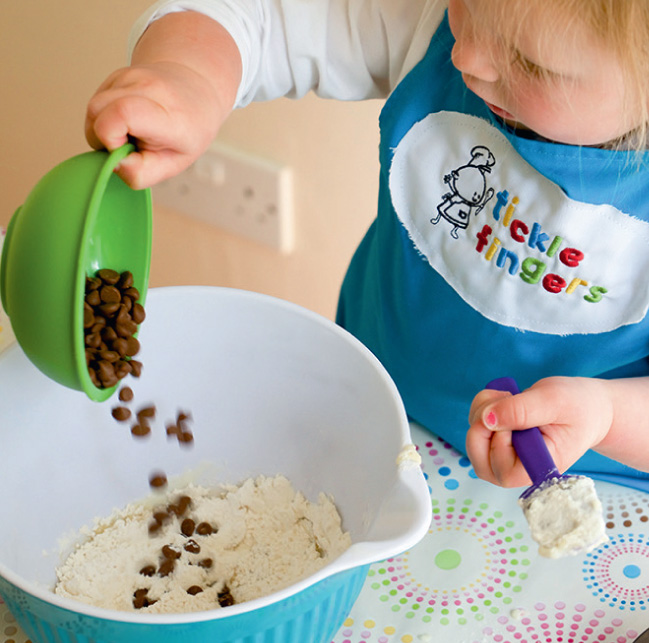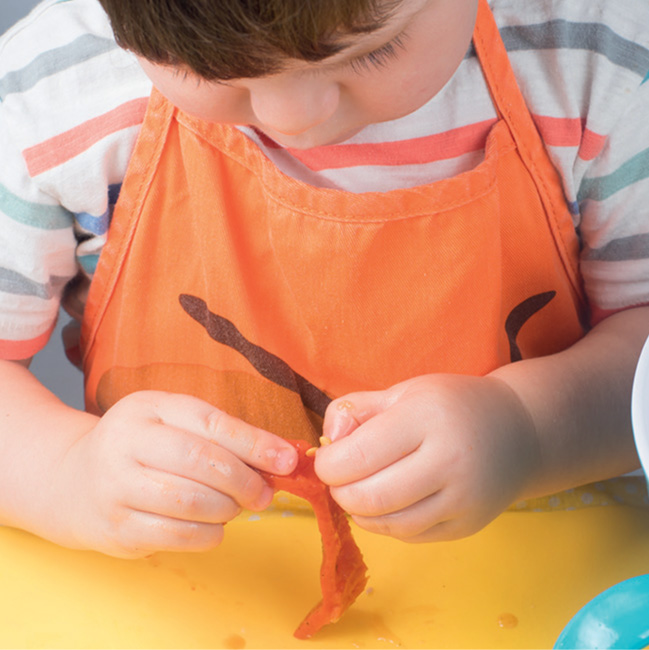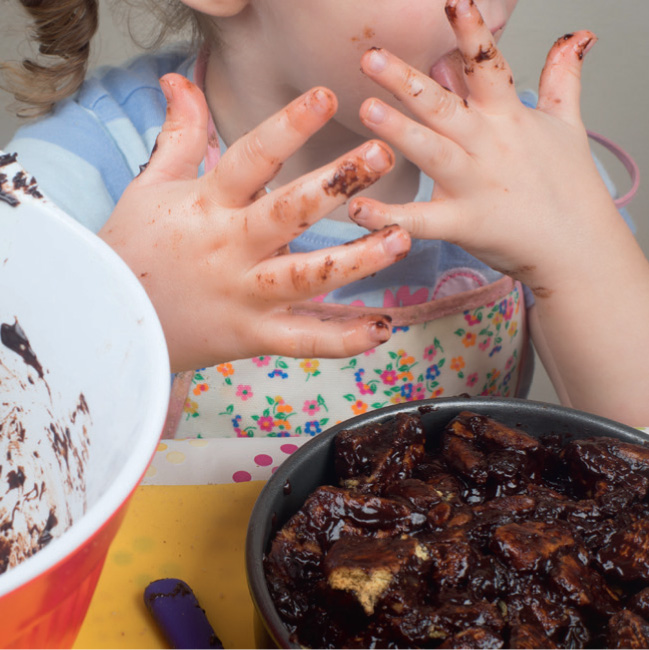

When my eldest was about 13 months old, we were living in a small, temporary flat with few toys and no transport. I was rapidly running out of entertainment ideas when I decided to attempt baking with her.
We sat together on the kitchen floor and made a childhood favourite of mine, chocolate fork biscuits (see here). She prodded the mixture, squished it in her hands and, of course, licked the bowl. It kept her happy for about half an hour and then even happier once the biscuits were ready to eat. There was mess to clean up (mainly on her), but remarkably little. Result? Happy mum, happy baby! It got me thinking that I should do more cooking with her.
To encourage them to use their fingertips, I tell them to pretend they are tickling the butter into the flour. We call this process ‘tickle fingers’.
Over the coming months that’s what I did, especially after her sister was born, as it gave us treasured one-on-one time together. She got increasingly involved and by age two, like it or not, I had a permanent ‘helper’ whenever I was in the kitchen. However, being short of time, with a young baby, I needed to get on with feeding the family, not just making fun cakes and biscuits.
I bought some children’s cookbooks and looked online, hoping to find dishes my daughter could make to serve at family meals. What I found were either recipes for fun snacks and children’s food or ones that she couldn’t do at her age without a lot of help. Most of the latter were too long and included steps that she couldn’t carry out safely, such as handling raw meat, using sharp knives/graters or stirring pans at a hob. The recipes advised that an adult should step in to do these bits, but I found that unworkable. She either got bored while waiting, or frustrated, shouting ‘I do it, I do it’.

After buying children’s cookbook number five, I gave up and decided to create my own recipes. I put together dishes that only involved cooking tasks she could do easily herself – sorting, mixing, squishing, bashing, pouring, covering, squeezing, tearing – and avoided tasks she couldn’t. I kept the recipes short, limiting ingredients and steps. I was more relaxed because she was happily engaged doing fun tasks with minimal input from me. And the more independence and control over the cooking I gave her, the more enthusiastic and skilful she became. Then I realised she was developing a curiosity about food that I hadn’t noticed before. Excited and proud about having cooked it ‘all by herself’, she was eating ingredients and dishes she had previously refused to taste. Even when she hadn’t cooked the food herself, she was more interested in what I cooked and intrigued about new dishes rather than fearing and rejecting them.

I can’t remember a time when I didn’t know how to cook. It was just something that was always going on at home. I’m no expert cook and continue to learn every day, but my mum gave me the foundations to build on; something I will always be grateful for and want for my own children. Starting to cook with them aged 18 months might seem young and for that reason fool-hardy. It wasn’t part of a grand plan; I fell into it. However, now that I’ve seen the benefits, it doesn’t seem so crazy. It’s odd that few of us question doing art, crafts and play dough with toddlers and yet the idea of cooking with them, using identical skills, is often still seen as daunting. This book aims to make cooking undaunting and approachable, particularly for those who don’t feel confident in the kitchen themselves.
The key to successfully cooking with very young children is to keep things simple.
The key to successfully cooking with very young children is to keep things simple. Cooking with children can be stressful, but the stress largely comes from attempting over-ambitious recipes and not preparing enough beforehand. The simplicity of the recipes and layout in this book (e.g. Parent Prep) are intended to make things as straightforward and stress-free as possible, including the shopping. I’ve tried to stick to common, everyday ingredients that you can pick up in most local mini supermarkets. However, simplicity does not have to mean that the food is tasteless. As anyone with a brilliant home-cook for a mum, like me, will know, you can have both simplicity and yummy food at the same time.
Why cook with tiny tots?
I believe cooking at a very young age has enhanced my children’s lives in the following ways:
‘Thanks for our food!’
A meal does not magically appear for them to accept or reject. Their direct involvement, or even just awareness of what goes into preparing a meal, gives them an interest in the outcome.
‘Can I try that?’
I am convinced that cooking has increased their interest in food and therefore given them a willingness to try new things. And this has helped us to create a more enjoyable atmosphere around meal times.
‘I can do it now!’
Watching my normally fidgety two-year-old carefully spoon flour into a bowl without spilling any has convinced me of the benefits for her focus and dexterity.
‘I did it by myself!’
Children love the idea that they’ve made something themselves for us all to enjoy. We always make a big play of thanking whoever was the ‘little chef’, just like they have to thank mum or dad for their meal.
‘Cooking is fun!’
It is always a struggle to find time to do fun things together. I know I am always promising them we’ll get the paints out ‘tomorrow’, only to find it’s the end of the week and I still haven’t. Cooking with small kids does take longer, but by involving them, we are doing something fun and constructive that needed doing anyway.
When I have an uninterrupted day to myself, I love to try out new, complex dishes. But now that I’m a mum, those days are rare. Most of the time, I just need ‘quick’ and ‘tasty’ food that all the family will enjoy. And when I am involving the children in the cooking, this is even more the case. With that in mind, the recipes in this book are full of shortcuts and sometimes make compromises to keep things easy. They are not about producing the ‘best of something you’ve ever tasted’ to impress with at a dinner party. They are about making it possible for young children to become a central part of everyday cooking for the whole family to enjoy.

Many researchers believe that our long-term eating habits are formed in the first few years, making it all the more important to get early experiences with food right. However, while we need to be mindful about balancing our children’s diet and watching salt and sugar intake, I don’t think this means we need to beat ourselves up if they refuse a specific vegetable or are partial to a small slice of cake.

I think the best thing we can do is try to ensure that our children are exposed to, and become familiar with, a wide variety of real (not processed) food, are open to trying new things, and feel positive and relaxed about food and eating. I don’t like the idea of labelling food as ‘good’ or ‘bad’. At this early stage in their lives, I want children to see all food as being interesting and fun. So, while this book aims to encourage them to eat more fruit and veg and choose healthier options, it is not about achieving the healthiest-possible diet or avoiding all sugary treats. I’ve tried to include a wide range of recipes for lots of different occasions, all designed to encourage children to explore and have fun with food.
My final note is a plea to grown-ups. The hardest thing about cooking with very young children is to let go, especially as far as mess is concerned. But you are the key to success here. If you are relaxed and give your children independence, they may yet surprise you with how much they can do by themselves. Trying to cook with a toddler underfoot used to be the worst part of my day. Now we do it together and it’s my favourite.
Enjoy!

Trying to cook with a toddler underfoot used to be the worst part of my day. Now we do it together and it’s my favourite.